5 Tips for Teaching Your Child to Ride a Bike
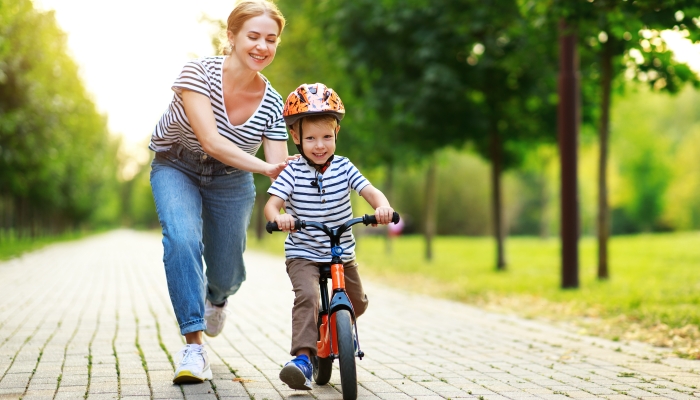
This post may contain affiliate links; please see our terms of use for details.
- Children are usually ready to learn to ride a bike between the ages of 3 and 8 years old.
- Your child must have the coordination, motor skills, vision, and balance skills to ride a bike.
- Practice makes perfect when it comes to cycling. The more time you spend on your bikes, the better your child will be at it.
- Helmets are an essential piece of safety gear when riding a bike.
- Balance bikes are generally considered a better starting point than training wheels nowadays.
Even if you haven’t ridden a bike for years, you likely remember the wonderful feeling of freedom you get cycling down a hill with the wind in your face. Not only can you get places faster, but you can travel further from home and explore new places easily. Cycling is a fantastic form of transport and, even better, great exercise.
Teaching your child to ride a bike is among the top parenting moments. There’s nothing quite like seeing your child enjoy the freedom and independence of cycling for the first time. That said, it’s also a bit terrifying. Kids on bikes move fast!
If you remember long summers spent cycling the streets of your hometown with your friends, you’re probably keen for your child to learn to ride so they can make memories of their own. Perhaps you’re imagining family bike rides on vacation, stopping for picnics along the way, taking in the sights.
If your child is desperate to learn, you’re probably wondering how to teach a kid to ride a bike. Is there a foolproof method to help your child master cycling? How can you help build your child’s confidence and prepare them for the safety aspects of riding a bike?
How to Tell if Your Child Is Ready to Learn How to Ride a Bike
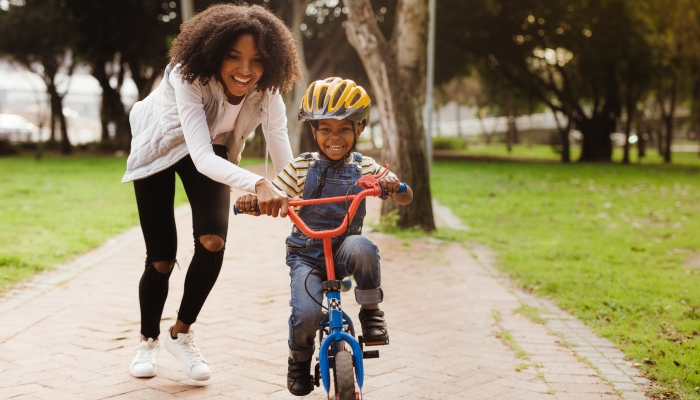
Most children are ready to learn to ride a pedal bike somewhere between the ages of 3 and 8 years old. If you wait too long, your child may be more nervous about learning to cycle. If you try too soon, however, you could knock their confidence.
Whether your child is ready to learn will depend upon their motor skills, coordination, balance, and visual-spatial skills. To cycle, your child must be able to steer safely around obstacles, pedal at the right speed, and stop and start safely. It might look easy, but riding a bike isn’t a simple thing to learn.
Here’s a test to see if it’s time to start learning how to teach your kid to ride a bike. If your child is developmentally ready to learn to ride a bike, they should be able to:
- Walk their bike down the street, turn it around, and walk it back to you.
- Climb on and off their bike without help. Your child needs to be able to swing their leg over the rear tire without assistance to mount their bicycle safely.
If your child can’t yet do these two things, it’s not time to teach them to ride independently. If your child can’t yet move the bike forward when walking, they’re unlikely to have the coordination and motor skills to cycle independently. Try again in a few months to see if they’re ready to start learning.
How to Teach Your Child to Ride a Bike: 5 Tips
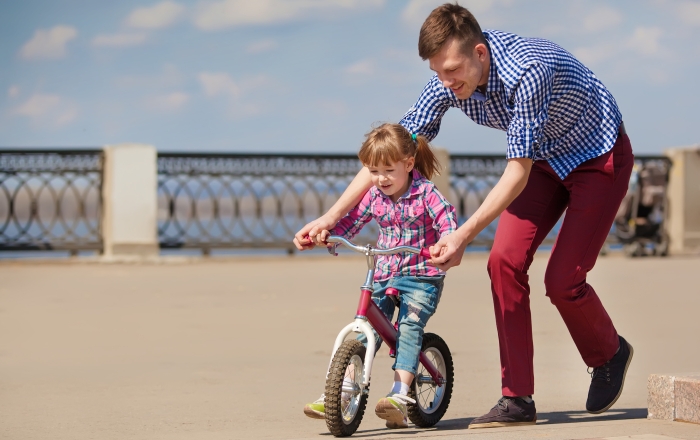
You know your child is ready and you’ve bought them a beautiful new bike. Now what? These tips will help get you cycling in no time!
- Make sure the bike fits: If your child uses a bike that’s too big or too small, they will find it more challenging to learn to ride. Head to your local bike shop for help picking out the right-sized bike for your child. Bicycles with smaller bike tires are easier to handle, so they’re perfect for learner cyclists. Your child will find it easier to maneuver a lighter bike, so it’s worth considering the weight of the bike, too.
- Invest in some safety gear: Helmets are a must when it comes to bike riding. Teach your child this important lesson by making sure they always have their bike helmet when they head out with their bike. Make sure the helmet is securely attached so that it would protect your child’s head in an accident. The next safety step is to teach your child about the brakes. Get your child to practice engaging the brakes, whether that’s squeezing the hand brakes or depressing the coaster brake, so they know how to stop in an emergency.
- Pick the perfect location; Location is important when it comes to learning to ride bikes. Your child needs to feel safe, so you don’t want any traffic nearby that may make your kid feel nervous. Pick somewhere with plenty of space, so your child can figure out steering without crashing into anything. Think about the ground covering. A lawned surface is soft to fall on but can make pedaling trickier. A proper sidewalk is smoother to pedal on. Opt for somewhere flat, so you don’t need to worry about your child picking up too much speed on their first go.
- Hold your child, not the bike: When helping a child to ride for the first time, many parents grab the bike seat or handlebars of the bike to give stability. Doing this, however, makes your child feel particularly unstable when you let go. It also stops them from getting a feel for the bike and how to balance on it. Instead, you should place your hands on your child’s hips to guide them while you walk alongside the bike; so they have complete control of their bike.
- Let your child go: Run alongside your child for a minute. This will give them a chance to start pedaling and get their balance under control. Once you can tell they have this in the bag, let go and watch them race ahead. Don’t let them go too far; call them to stop so they don’t get too far away from you while they’re still learning. You will notice your child’s confidence growing each time they successfully cycle independently, and they’ll soon be ready for a full lap without help.
What safety measures should always be observed when teaching a child how to ride a bike?
Bikes move fast, so your child must know how to stay safe while riding. A helmet will help to protect their head in an accident, so make sure this is non-negotiable each time they head out with their bike. It helps to store their helmet with their bike, so there’s no excuse for forgetting it.
Make sure your child has brakes they can use. Try the brakes in the shop to ensure your child can use them easily. Teach your child to test their brakes before each bike ride; this is a good habit that could one day pay off. Most bikes rely on brake levers, but some bikes for younger children use coaster brakes which are more accessible for small hands.
What are some common mistakes to avoid when teaching a child to ride a bike?
Pressure is one of the biggest things to avoid when teaching a child to ride a pedal bike. Your child likely won’t do well if they feel under pressure. Learning to cycle should be fun, and kids learn faster when they are motivated. This is a great opportunity for your child to build their confidence, develop trust in their abilities, and gain some independence.
Don’t put pressure on your child to learn. If they’re not interested in learning, leave them be and let them learn at their own pace. If you want to encourage an interest in cycling, model cycling for them at every opportunity. The more bikes are a part of their life, the more they’ll want to learn to ride.
Kids pick up on our emotions. If you seem nervous or scared, your kid will know. Not only that, they’ll end up feeling the same way. Try to be relaxed and confident while your kid is learning to ride a child’s bike. Even if they take a tumble, there’s no need to panic; just be a calm and reassuring presence while they learn this new skill.
How Long Does It Take to Teach a Child to Ride a Bike?
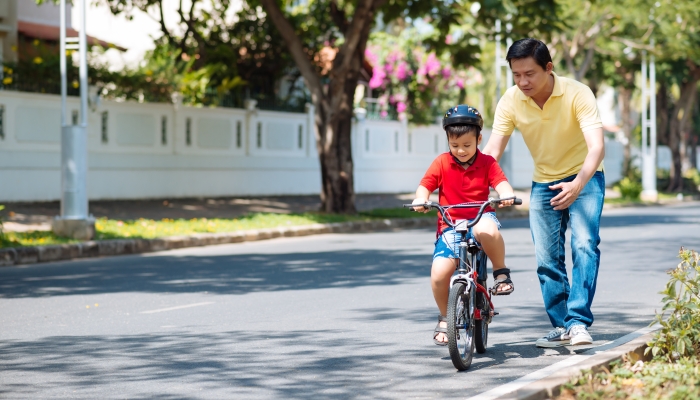
How long is a piece of string? There’s no fixed amount of time to teach a child to ride a bike; how long it takes will depend on many factors, including confidence, luck, and timing. It’s absolutely possible to teach your child to ride a bike in a single outing, but it’s better to lower your expectations so that you (and your child) aren’t disappointed if it doesn’t happen on the first day.
Even once your child has mastered the basics, it will take a while for them to finetune their steering ability. You’ll want to stick to wide-open spaces for cycling for the foreseeable future. Once your child has their balance and steering skills down, you should focus on safety skills such as emergency stops and how to avoid collisions safely.
FAQs
Should I use training wheels or a balance bike to help my child learn?
- Perfect Starter Bike for Toddlers – Discover this lightweight balance bike for ages 18 to 48 months. The Charlie balance bike helps kids master balance and coordination, preparing them for a pedal bike confidently and safely.
- Adjustable Seat & Handlebar – Customize this balance bike with an adjustable seat (11-14.6 inches) and handlebar (18.9-20.1 inches). The bike grows with your child, ensuring comfort and stability as they learn.
- Durable, Lightweight Metal Frame – Designed for daily adventures, this toddler bike has a sturdy, lightweight metal frame that promotes gross motor skills, making it easy and fun for little riders.
- Easy-to-Carry with Integrated Handle – Weighing only 5.5 lbs., this balance bike is simple to carry thanks to its built-in handle. Take this favorite ride-along toy to parks, sidewalks, and more.
Old school training wheels were probably standard back when you learned to ride. Nowadays, most experts recommend using a balance bike to prepare your child for learning to cycle. Balance bikes usually have two wheels (some have three) and a seat, but no bike pedals. Your child’s feet push the bike forward and they learn to balance when when they lift their feet off the ground.
Though training wheels help your child practice pedaling, balance plays the most crucial part in learning to cycle. Balance bikes are the perfect way to help new riders develop their balance skills.
You may remember from back when you learned to cycle that having your training wheels removed suddenly made cycling feel scary. Many families skip the training wheels altogether to avoid the battle of removing them.
If you don’t want to fork out for a balance bike, you could create a temporary balance bike by removing the pedals on your child’s regular bike. This will create a DIY balance bike so your child can get used to balancing on a moving bike before learning to pedal.
How can I help my child overcome their fear or hesitation about riding a bike?
There’s no rush to learn to ride a pedal bike. You may be keen to go on family bike rides or want them to learn with their peers, but there’s little point in rushing it. If your child isn’t ready, wait until they are. At some point, their desire to ride will overpower their fears, and they’ll want to learn.
In the meantime, build your child’s confidence in their physical ability. Celebrate their achievements. The more they trust their body, the better they’ll feel about learning a new skill.
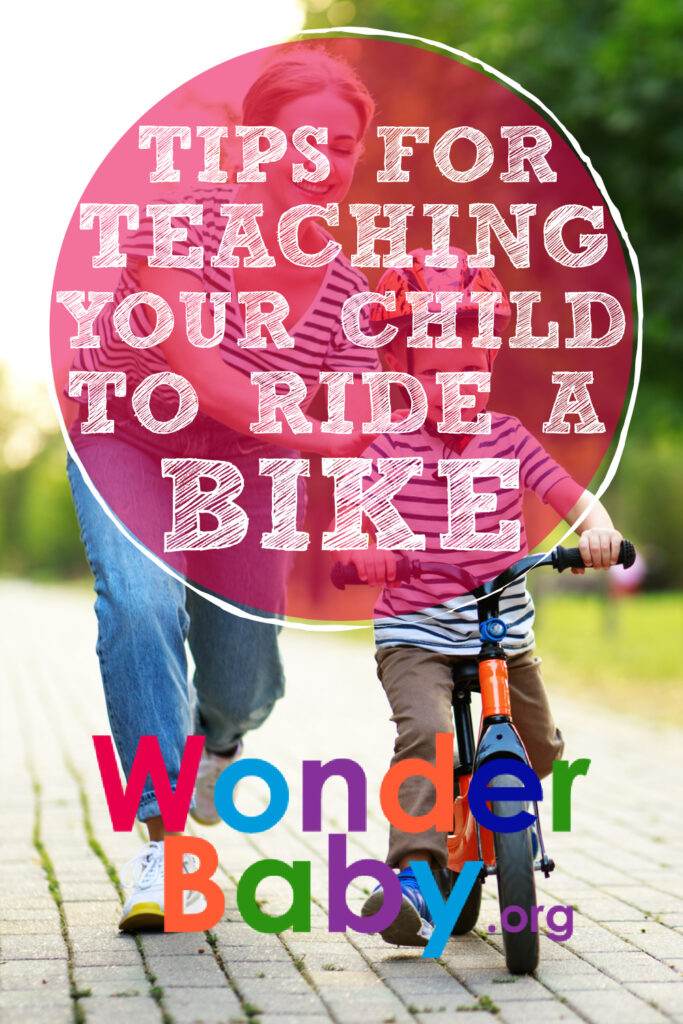
Related Posts

Braille and Literacy, Toys, Visual Impairment
24 Braille Toys for Kids Who are Blind
Everything from alphabet blocks to raised line coloring pages and activity books to puzzles to card and board games... and so much more! And it's all in braille ready for...

Holiday Crafts and Ideas
Should Parents Lie to Their Kids About Santa Claus?
Should parents lie about Santa? Find out how to balance trust, magic, and holiday traditions right here!
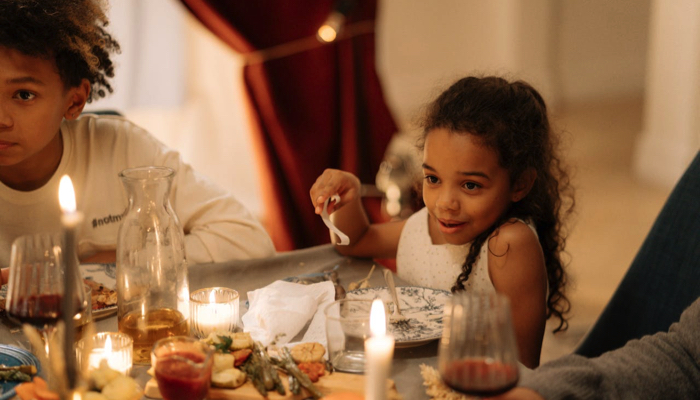
Holiday Crafts and Ideas, Special Needs
5 Tips for a Peaceful Thanksgiving with Your Child with Disabilities
Thanksgiving can be a joyful yet overwhelming holiday, especially for families with children who have sensory, motor, or dietary needs.
